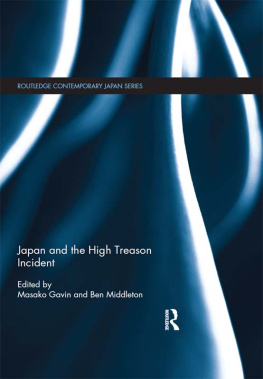First Published in 2001
by Curzon Press
Reprinted 2004
By RoutledgeCurzon
11 New Fetter Lane, London EC4P 4EE
Transferred to Digital Printing 2004
RoutledgeCurzon is an imprint of the Taylor & Francis Group
2001 Masako Gavin
Typeset in Horley Old Style by LaserScript Ltd, Mitcham, Surrey
Printed and bound in Great Britain by
Hobbs the Printers Ltd, Totton, Hants
All rights reserved. No part of this book may be reprinted or reproduced or utilised in any form or by any electronic, mechanical, or other means, now known or hereafter invented, including photocopying and recording, or in any information storage or retrieval system, without permission in writing from the publishers.
British Library Cataloguing in Publication Data
A catalogue record of this book is available from the British Library
Library of Congress Cataloguing in Publication Data
A catalogue record for this book has been requested
ISBN 0 7007 1304 2
The Publishers gratefully acknowledge the generous contribution of
the Japan Foundation in support of the publication of this book.
Preface
When Dr Yshi It, my PhD supervisor at Victoria University of Wellington, first told me of Shiga Shigetaka and his book about the South Seas, I was curious as to how a nineteenth century Japanese intellectual could know so much about countries such as Australia and New Zealand, which today, as APEC members, link the Pacific rim economically as well as geographically. I had never heard of Shiga before, yet I immediately became very enthusiastic about his views, and devoted myself to research about his life and thought.
Shiga was an important Japanese intellectual of the Meiji era. His major works, Nan'yjiji (Current Affairs in the South Seas) and Nihon fkeiron (Japanese Landscape), were best sellers in the 1880s and 1890s, and the latter continues in print to the present day. However, as I discovered, only a few references to him exist in either English or Japanese, and his intellectual activity has long been forgotten by the general public in Japan. Worse, I found that, where he is remembered, in many cases it is as a conservative and imperialistic intellectual. As I read more about Shiga and particularly when I read those of his works which are not included in so-called Shiga Shigetaka zensh (Complete Collected Works of Shiga Shigetaka), I was repeatedly struck by a disparity between the breadth of his own ideas and these limited caricatures of him.
Clearly there were contradictions in Shiga's ideas. On the one hand, he was a pioneering advocate of kokusui shugi, a theory which called for the preservation of Japan's cultural identity and seemed to fly in the face of the increasing internal and external pressures toward modernisation that existed in the late 1880s. On the other, as he had himself received a western education, he was enthusiastic about Darwinian theories, and was a great admirer of the British, whose mighty spirit he had witnessed at first-hand in Australia and New Zealand on the cruise through the South Pacific, which inspired his first book Nan'y jiji.
Having lived in both New Zealand and Australia, and having been fortunate enough through one of my former careers to have visited most of the other destinations covered by the Nan'y jiji cruise, such as Fiji, Samoa, and Hawaii, I felt that I could bring new insights to a study of Shiga's thought and its contribution to Japanese modern intellectual history. Japanese scholars of Shiga's work have been hampered by conventional approaches, by the limited references available within Japan and by a failure to understand Shiga's global view, based as it was on his first-hand experiences of world travel, quite unique for an intellectual of his time. His call for the preservation of cultural identity while remaining in harmony with the cultures of others still conveys a valuable message not only to the Japanese in Japan and overseas, but to all who live in today's globalised society.
Portions of this book have appeared in English in earlier versions: Shiga Shigetaka's Nan'y jiji (Current Affairs in the South Seas), New Zealand Journal of East Asian Studies, vol. VI, no. 1, 1998; Educating for a New Japan: Shiga Shigetaka's Criticism of the Imperial Education System, Japanese Studies, Japanese Studies Association of Australia, vol. 18, no. 3, 1998; For Japan's Survival: A Reconsideration of the Myth of Shiga Shigetaka as a Conservative Intellectual, East Asia: An International Quarterly, Rutgers, vol. 17, no. 3, Autumn 1999; Nihon Fkeiron (Japanese Landscape): Nationalistic or Imperialistic?, Japan Forum, vol. 12:2, Autumn 2000. In this book I have tried to keep the notes to a minimum and hope that, for further information, readers who are interested in scholarly details of this work will refer to the above articles and/or my PhD dissertation, The Forgotten Enlightener: Shiga Shigetaka (18631927), Victoria University of Wellington, 1998.
At every stage of this project I have been supported by many scholars, friends, archivists and librarians. It is therefore impossible to name all for their assistance, but I owe my heartfelt gratitude to Dr Yshi It, Prof. Raoul Mortley, Prof. Harukiyo Hasegawa, Prof. Henry Frei, Michelle Golder, Louise Webb and John Gavin. I am also indebted to the librarians at the following institutes for their invaluable assistance; the Alexander Turnbull Library (Wellington), the Mitchell Library of the State Library of New South Wales (Sydney), Asian Collections of National Library of Australia (Canberra), Main Library of Bond University (Gold Coast), National Archives of Fiji (Suva), the Royal Geographic Society (London), National Diet Library of Japan (Tokyo), Hopp Shiryshitsu of Hokkaido University (Sapporo), Central Library of Waseda University (Tokyo), Tokutomi Soh Kinenkan (Kanagawa) and Okazaki Kydokan (Aichi), Japan. As for the illustrations, the photos of Frederick Langham and Shiga's article in The Sydney Echo, have been prepared by the Mitchell Library of the State Library of New South Wales, and those of Wi Tako, City of Wellington in 1885 and an article (regarding Shiga's lecture) in The New Zealand Mail, by the Alexander Turnbull Library, National Library of New Zealand, Te Puna Mtauranga o Aotearoa.
I hope that this book will promote a wider interest in the thoughts not only of Shiga, but also of those of his contemporaries who lived during a crucial period in the Meiji Japan, and will lead to further research in the field of Japanese modern intellectual history. Although so many people deserve credit for any quality which this book may have, I bear sole responsibility for any remaining errors and for all interpretations and conclusions.










